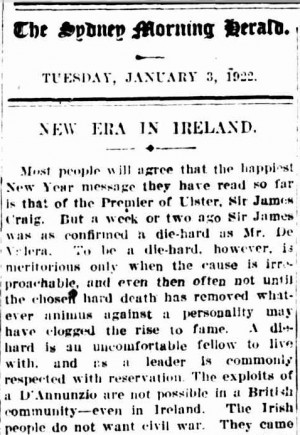After years of war and months of negotiations the Anglo-Irish Treaty was signed in the early hours of 6 December 1921 by Irish and British delegations in London. In Dublin, a fierce debate began in Dáil Éireann over the terms of the agreement, ending with a vote to ratify on 7 January 1922.
It was clear from international media coverage of the Dáil debates that the general view of the Anglo-Irish Treaty was a positive one. Even where some of the terms were considered unfair many saw it as an acceptable means of bringing an end to the terrible violence of the previous few years, with the possibility of negotiating further in the future. As the final days of the debate came in early January differing accounts were given across the world about the likely outcome.
The Sydney Morning Herald, 3 January 1922
Australia, as a self-governing dominion within the British Empire, was generally supportive of the move to apply a similar status to Ireland. There was widespread media coverage of the Anglo-Irish Treaty debates, with most newspapers reflecting the moderate opinion that the terms of the treaty should be accepted by the Dáil. As early as 3 January The Sydney Morning Herald highlighted what it viewed as the softening stance of prominent politicians James Craig and Éamon De Valera, commenting optimistically that “the plain English of these messages is that the die-hard leaders realise that they are out of touch with their people and are giving way as gracefully as possible”.
Source: Trove
